|
Posted: 5/10/2011 1:23:37 AM EDT
[Last Edit: TheGrayMan]
Disclaimer: I'm not a CCTV professional. I'm not licensed to do this kind of work, don't make my living from it, and advise anyone reading this to make an honest assessment of their own abilities before jumping into a DIY camera system.
Intro: Safety and security are never far from the minds of most gun-owners. People who have chosen to own guns for their personal protection tend to take a far greater interest in their own personal security than the average person, and likewise take a strong interest in the security of their homes. This is mostly because the "Home = Castle" doctrine is firmly planted in the minds of most posters here, but also because home is where you live, eat, sleep, and house your family. When discussing home security, one gets into high-security deadbolts, reinforced doors, motion-sensor lights, window films, driveway sensors, alarm systems, dogs, safes... and the discussion eventually turns to security cameras. A quick Google search of the topic will literally produce hundreds of thousands of hits, many to websites that hawk the latest/greatest security camera systems, always at a GUARANTEED LOW LOW PRICE (!!!). Be wary. There is an extremely wide range of products out there, in price points ranging from $20-per-camera, to $1500-per camera... and the relationship between price and performance is decidedly non-linear. A basic security camera system-in-a-box can be had at any number of "big box stores" for as little as a few hundred dollars on-sale, with four day/night bullet cameras, and a self-contained DVR. This seems quite reasonable, and it is... if all you want is basic functionality, a rough idea of what's happening, and don't expect CSI-level detail out of the recorded video. Forget about getting a license plate number off the car the burglars were driving, and face shots may be too grainy to identify very much. You'll know that somebody was creeping around out there... but good luck identifying them unless they're practically on top of the camera. The DVR is totally proprietary, and might only last a year or two. Once it dies, getting replacement parts will be impossible. You won't be able to expand it past the original four cameras. The cameras themselves are probably 1/4" or 1/3" CMOS cameras, and this will limit their night-time performance. They may or may not be very weatherproof... But that's what you get for a few hundred bucks. Some people don't need any more than that... and those folks are served perfectly well by that type of system. Even if it only lasts for two years, they've probably gotten their moneys worth. Then there are the folks who want an NSA-type uber-system, where they can bring up 20 different megapixel camera views from anywhere in the world and spring traps on intruders with a touch-of-a-button on their cellphone. These folks should consult a professional... I can't help you with something that elaborate. Incidentally, the consult-a-professional advice is never a bad idea for anyone who doesn't feel up to the task. CCTV isn't rocket science, but there is definitely a professional body-of-knowledge, a significant learning curve, and a certain amount of expertise involved in system design, camera selection, DVR construction, installation, and so forth. A guy who has been doing this stuff for ten years has a head full of hard-won experience, and can help you avoid some pitfalls that you might otherwise encounter. That expertise is worth something... so consider a professional if you get stuck, and be prepared to pay him/her. It will probably be worth it. Even if you don't end up DIYing it, after reading this thread, you should have a much better idea of what questions to ask a potential installer. Camera types: Cameras come in two main flavors: analog and IP-based (also called network cameras). Analog cameras have been around since Methuselah, and still make up the bulk of cameras sold today, particularly the bargain-level systems. They typically operate on 12VDC (dual-voltage models will also take 24VAC), and output an analog video signal on the NTSC standard (PAL if you're in Europe). You can literally plug the video cable of these camera into the "Video In" RCA jack on your TV, and get a picture. These cameras are typically connected via "Siamese" cable, which is usually RG-59 coaxial cable, and 18-gauge two-conductor power wiring (for either AC or DC power). The connectors most commonly used are BNC-connectors for video (RCA occasionally), and barrel-connectors for power. See pictures below: Analog cameras with BNC and power jacks circled: 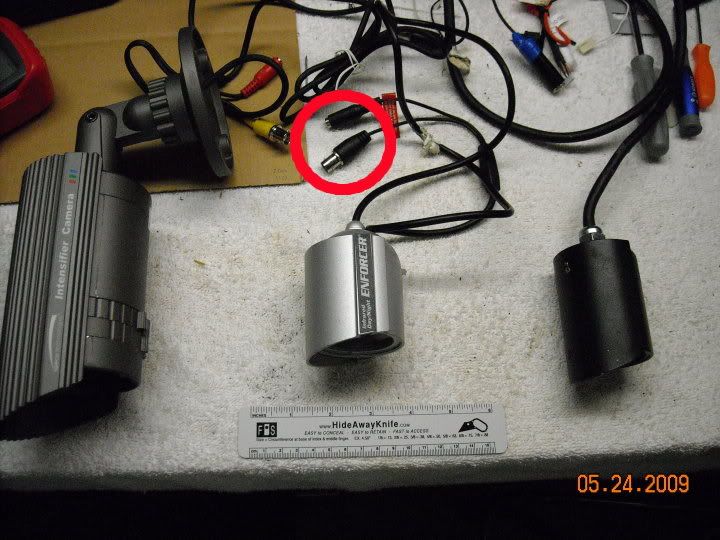
Siamese cable: 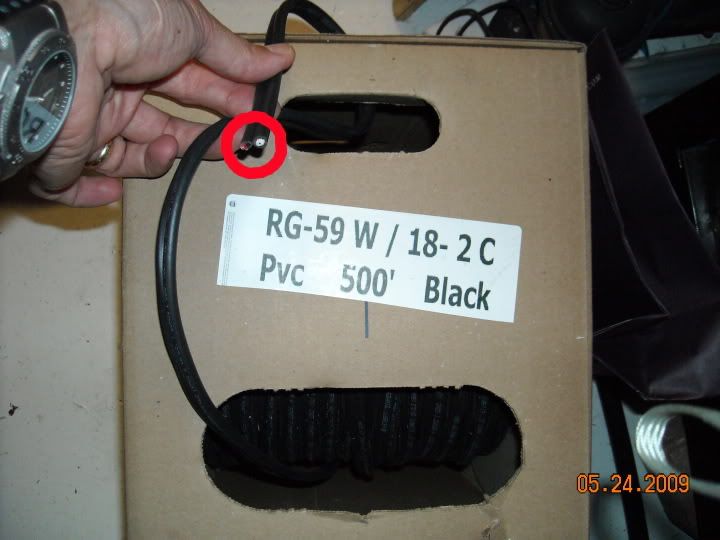
Two different analog cables. Pre-made on left, stripped-but-unterminated Siamese on right. Crimper highlighted with arrow: 
Some connectors. Those are barrel connectors on the right (2), and a BNC-to-BNC connector in the middle: 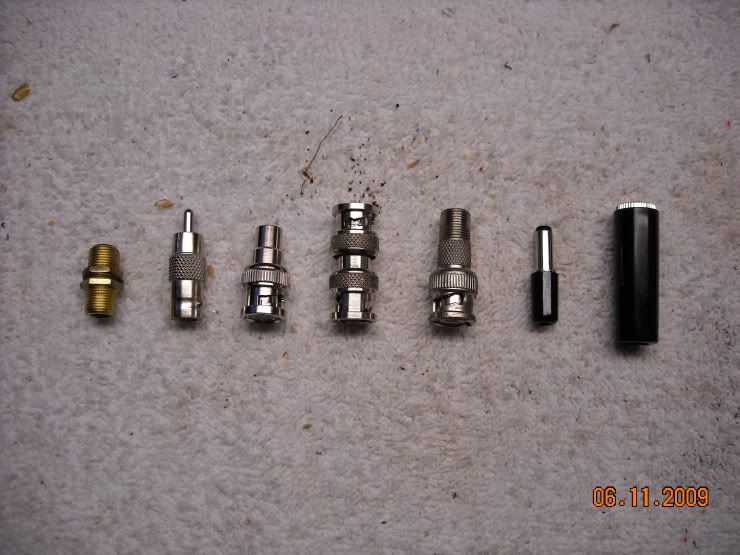
There is another category of cameras, and those are the IP-based network cameras. These are a more interesting lot, and more expensive. These cameras can be almost entirely autonomous, and are like their own mini-computer. They run their own internal webserver, process their own image data, do their own motion detection, and can send you pictures, alerts or emails. You can open up your web browser, type in the camera's web address, and have an image in seconds. Some will record image data to internal storage in addition to sending it to a central DVR. They also tend to have MUCH higher resolution than a regular analog camera. Ever compared regular old analog TV side-by-side with HDTV? It's like that. To give you an idea of the difference in megapixel IP cameras to the older analog cameras: Look at the first picture carefully. Note the inset images on the right-hand side. See how the license plate gets clearer in the megapixel image, compared to the CIF/2CIF image? That's because the pixel density of the megapixel image is much higher. If you take the same scene, and photograph it with more pixels, there is more image data contained in the picture, so enlarging it will show clearer details. If you take a low-resolution or low-pixel-density image and enlarge it, everything quickly becomes boxy or pixelated... the image data just isn't there. 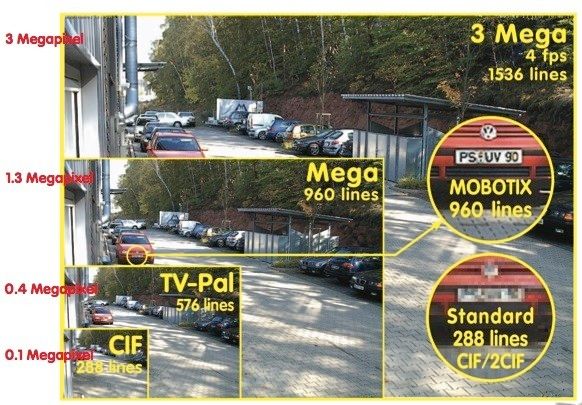
Here is an interesting link that demonstrates the phenomenon. Go over and click on it... I'll grab a couple of the images here to save you some time (and their bandwidth). Here is a CIF image: 
Here is a 1MP image. Notice how in the second image you can not only make out the satellite dish on the side of the house, but see that it's a DirecTV dish? That's because that image contains a lot more "data" than the CIF image. 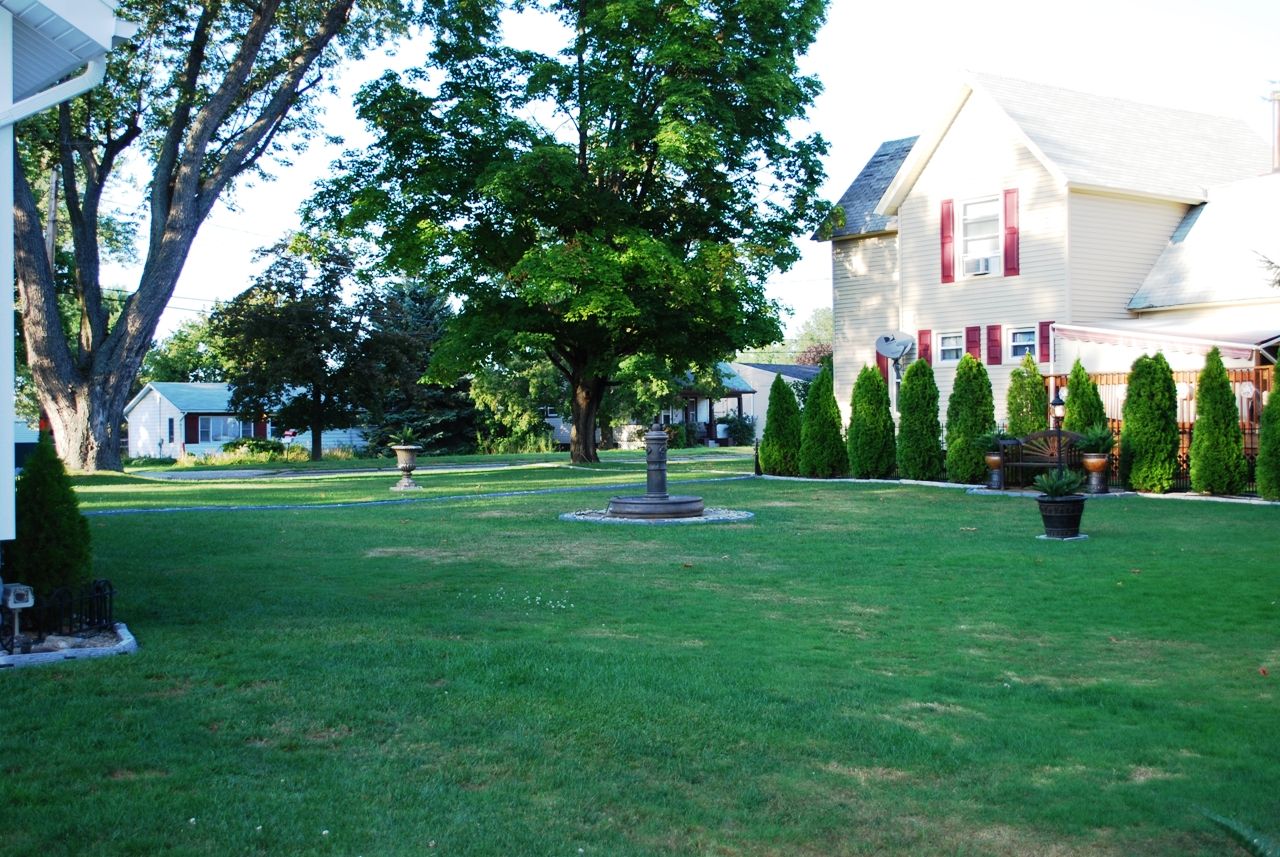
Now let's blow up that CIF image to the same size as the 1MP image. See how blurry/blocky/pixelated the image is? That's what happens when you attempt to enlarge a low-res image... unlike Hollywood or CSI, you can't make data appear where there isn't any data. 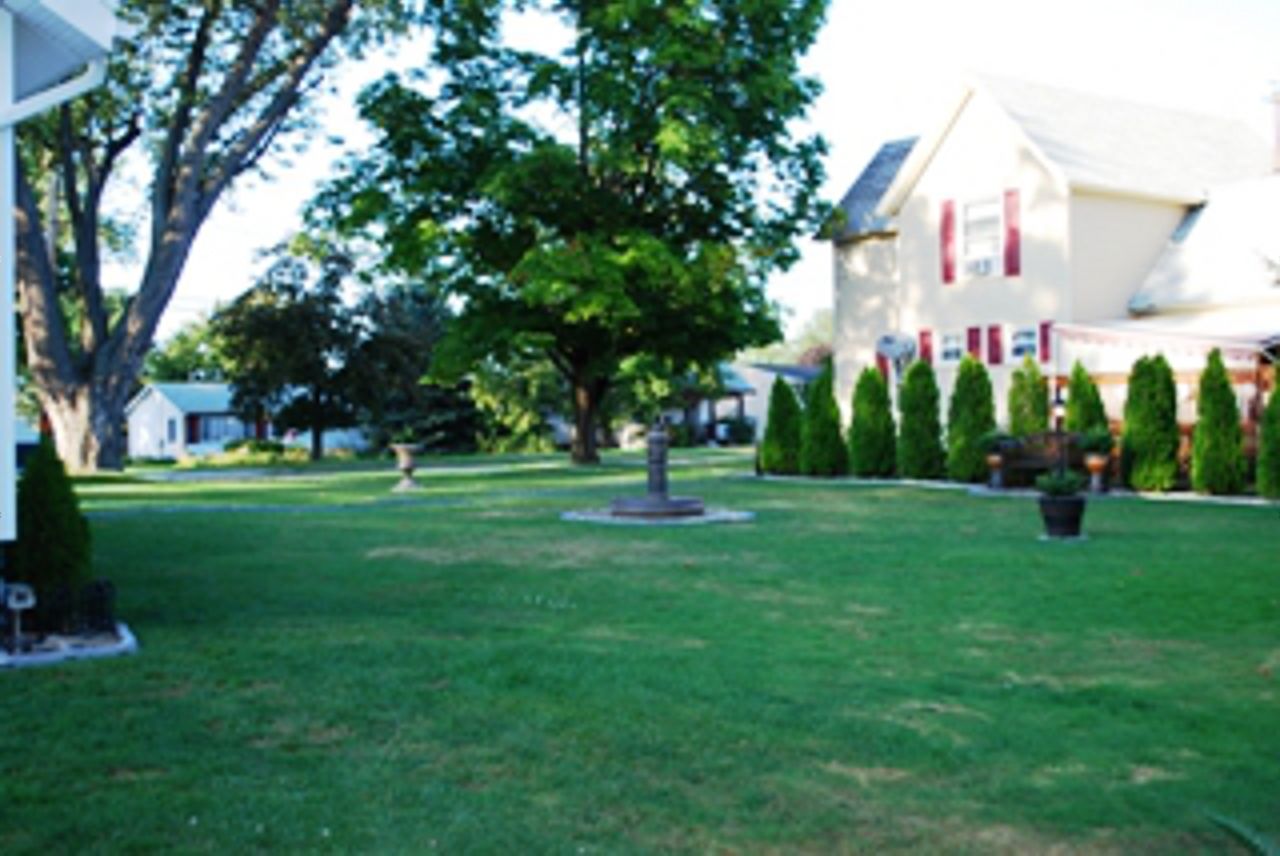
Here's another image to give you a sense of pixel density, and what it does to your chances to ID a face, or a license plate: 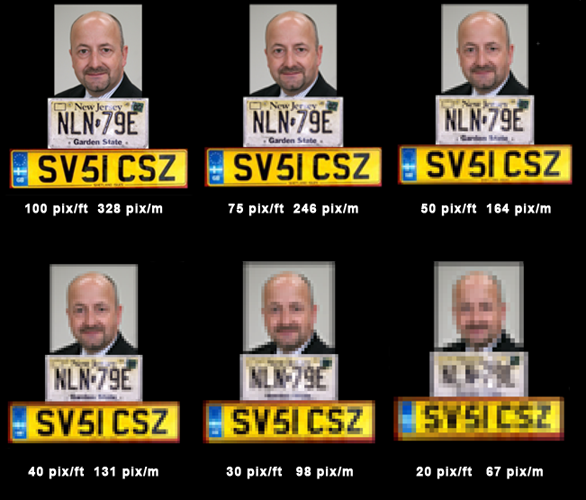
IP cameras really shine in the pixel-density department, since they're capable of much higher resolution pictures than the older analog standard. To drive that point home, here's a straight-up, same time-of-day, same scene comparison between an analog Speco intensifier, and a 1.3MP Acti ACM-1231: 
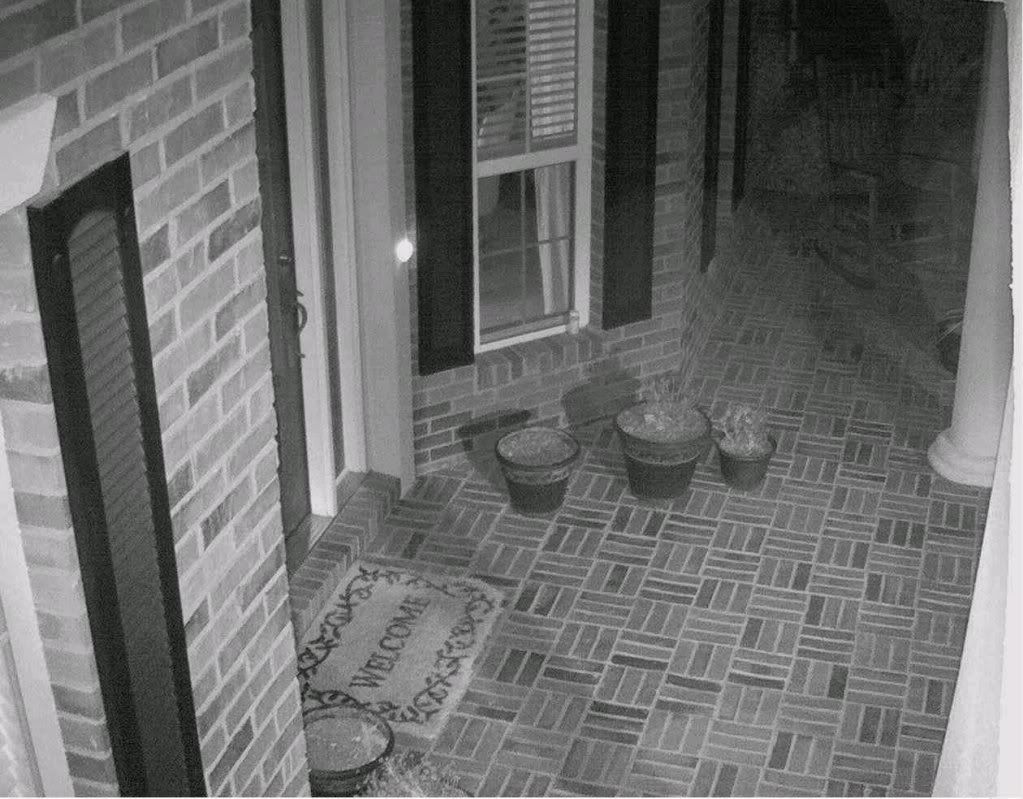
IP cameras also connect differently than an analog camera does. Network cameras, as the name might imply, require a network connection; they use the very same Cat5 or Cat6 cable that you're using to connect your desktop computer to your router or home network. They also have the capability to draw their power through the same cable, via "Power over Ethernet" (the spec is 802.3af. Here's a link if you want to read about it on wikipedia). Power-over-Ethernet (abbreviated hereafter as PoE) saves you a lot of time and hassle when it comes to install your system... you can run a single cable for power AND video. Here is a network camera, with the Cat5/6 jack circled (top). This one can also take 12VDC directly, through the second circled jack (bottom) 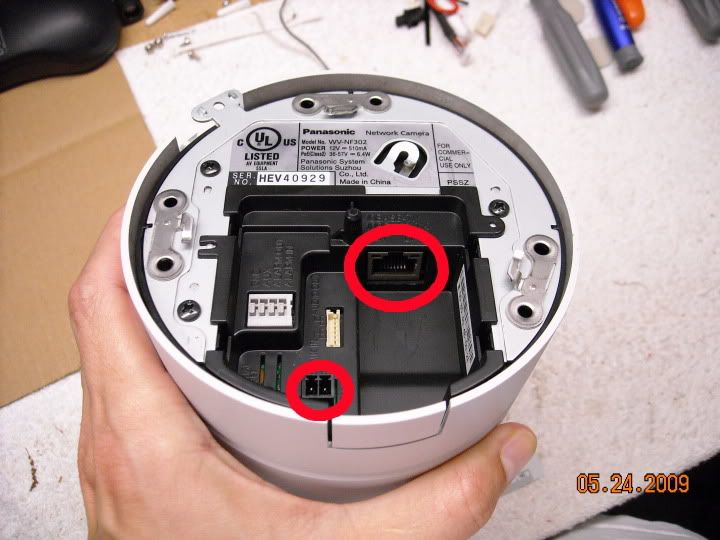
They plug into a switch just like this one. The top four ports are regular network ports, like you might find on any home's wireless or wired Linksys/Dlink/Netgear/Belkin/etc router. The bottom set of ports supplies PoE in addition to network connectivity. 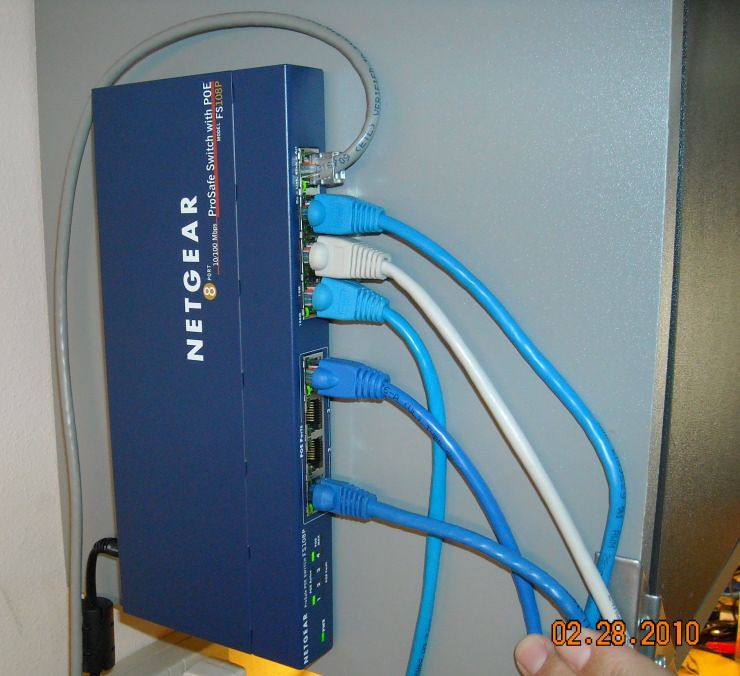
Naturally, since the two camera types are powered differently, you'll need one of two different types of power supplies. The top one in this picture serves 12VDC to analog cameras, and the bottom one is a PoE network switch. The PoE network switches also come in rack-mount versions, as in the second picture: 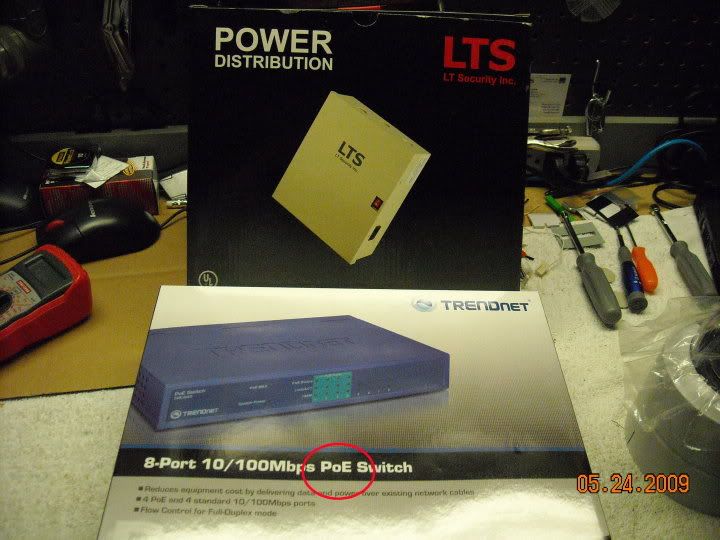
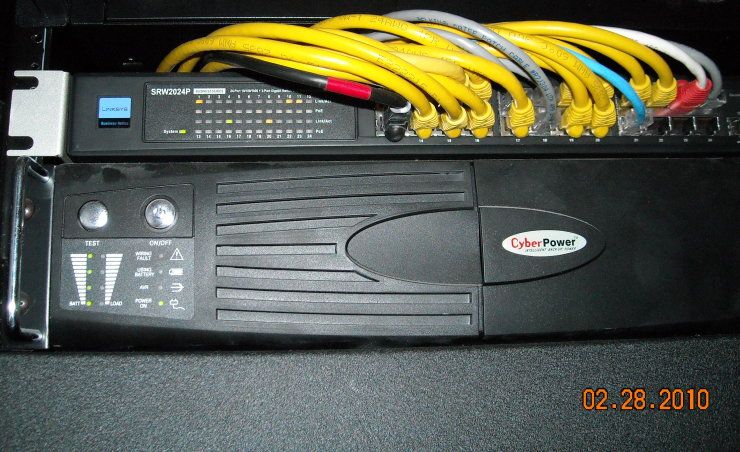
Since the two camera types create and send their data differently, they often connect to two different types of DVRs. Analog systems most commonly use an "embedded" DVR, which is a generic box-looking device with some buttons on the front, and a bunch of BNC jacks on the back. This device digitizes the video streams it receives (eg. turns them into storable digital data), and puts them on an internal hard drive. Depending on the size of the drive and number of cameras, it will record for a variable length of time... often a week or two. 
A network DVR receives video streams just like the analog DVR does, but the pictures have already been digitized at the camera-end, so it's simply a matter of collecting the images and storing them. There's no need for the network DVR to dedicate CPU cycles to creating the picture from an analog signal, since that work has already been done. The network DVR also connects to the network with a single cable (assuming your system isn't overly large... if it is, you'd better be using a separate gigabit network... or consult a professional to help you design it). Network DVRs can be of the same box-looking form-factor as an embedded analog DVR, but a regular PC can be used, as shown here. When doing so, one should consider beefing up certain components, like the network card, and the hard drive (an enterprise-class drive will hold up to the constant data-writing better than a regular consumer-grade hard drive). You can also add an analog encoder or "DVR card" to an existing PC-based network DVR, and use it to digitize analog streams... just make sure it's supported by the software you plan on using. This would be called a "hybrid" system (network and analog cameras on the same system). Thinkcentre former "cube farm" desktop computer being used as a DVR: 
A dedicated rack-mount PC-based DVR: 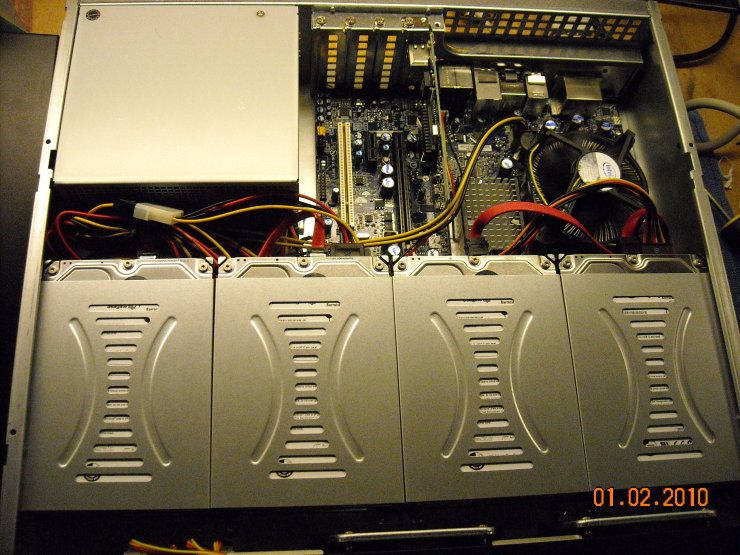
As for the cameras themselves, they come in all sorts of shapes, sizes, colors, and form-factors. You can get either analog or IP in almost any form factor, with the exception of very small covert cameras. Those are almost entirely analog. Bullets (these are all analog) 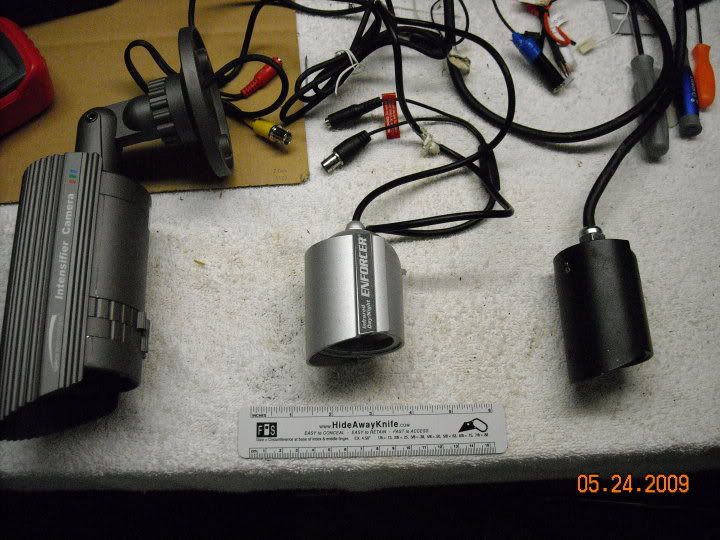
Bullet: (this one is IP-based) 
Covert "board" camera (analog... virtually anything this small will be analog): 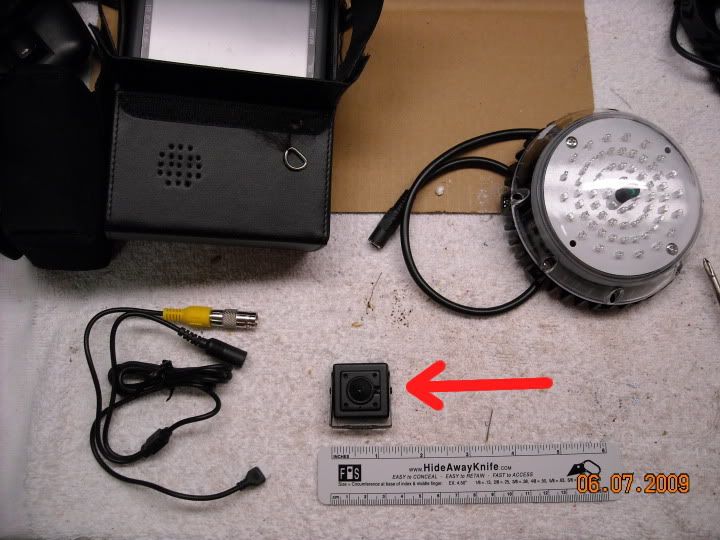
Dome (this one is IP-based) 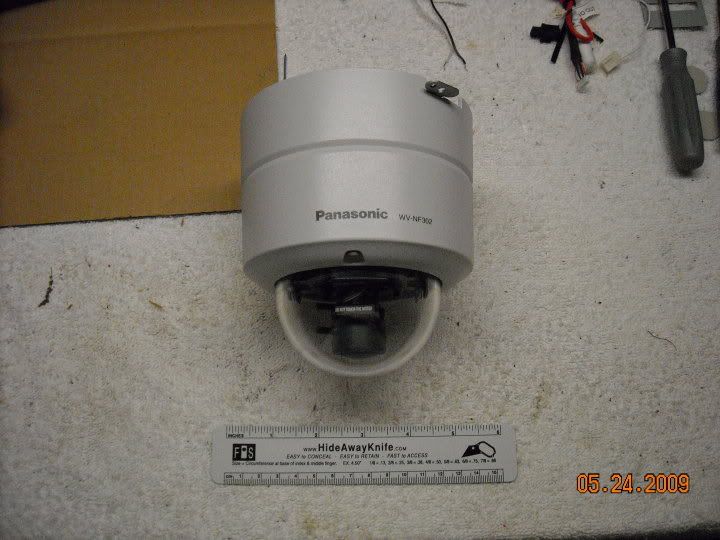
Another dome (this one is analog): 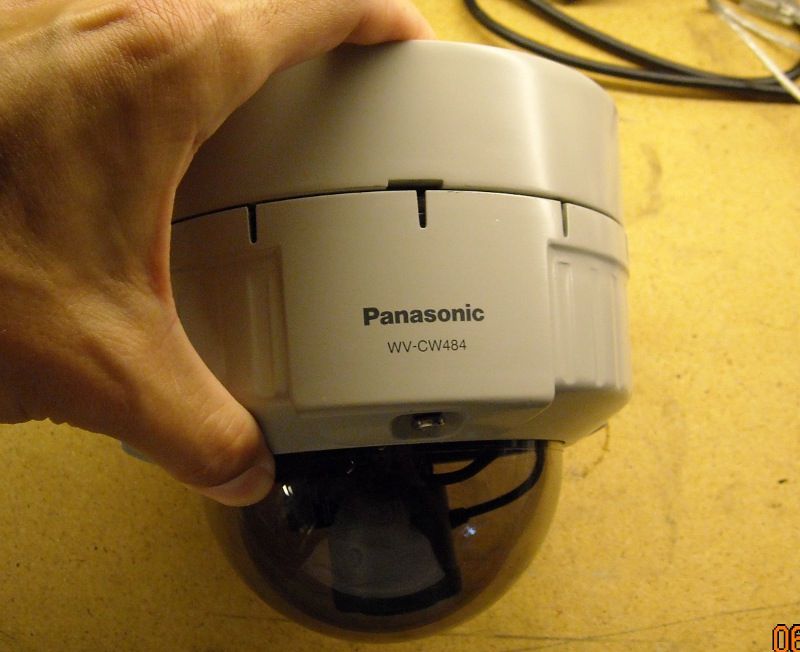
Dome with cover off (this one is IP): 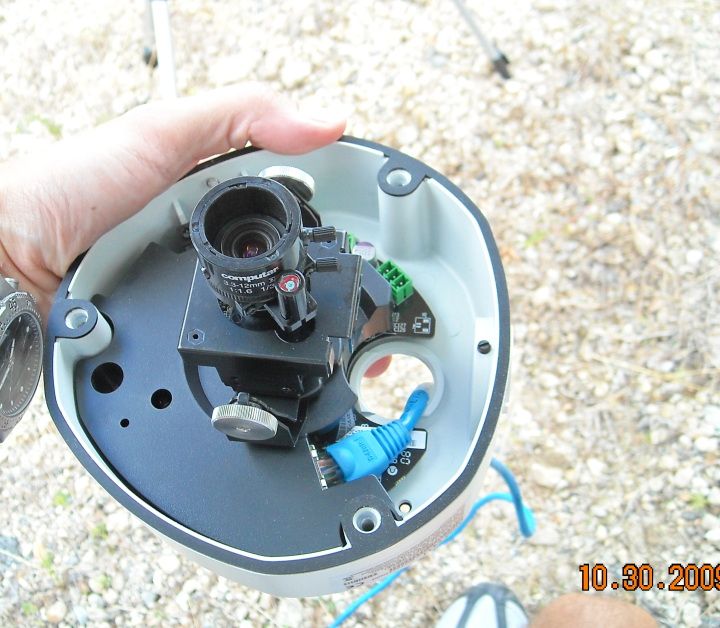
Domes and Bullet cameras each have a certain set of advantages. Feature __________________________Bullet___________________________Dome cost ....................................................cheaper...............................................more expensive mounting...............................................easier.................................................. harder Visibility.............................................more-visible............................................. less visible Wiring concealed.................................not usually......................................................yes Vandal-resistance..................................worse.....................................................better weather resistance.................................same.....................................................same integrated IR.......................................common................................................less common PTZ..................................................no.................................................... possible (more $$$) coverage area obvious?..........................yes........................................................no can be redirected easily?..........................yes......................................................no |
|
|
"Look wise, say nothing, and grunt. Speech was given to conceal thought."
- Sir William Osler - |
|
Originally Posted By donnieR32:
Thy Gray Man: I have a question to add to my first questions. I need to know what my best option is for a camera that far from my house. Could I use wireless? Considering the low light levels I assume having the camera attached to the pillar would provide enough ambient lighting for NV or inferred (please advice if my terminology or theory is incorrect) to see anything in the area. Ideally, I'd like a set up that allows me to add cameras over time, I can review the footage, and connect a live feed to one TV in my house. Please, ask me any additional questions you have. Thanks in advance. View Quote Do you have line-of-sight to the end of your driveway? If you do, you could use wireless. Is there power down there? |
|
|
Everything you are doing is wrong, and it is my sworn duty to resist you.
|
|
Originally Posted By TheGrayMan:
Do you have line-of-sight to the end of your driveway? If you do, you could use wireless. Is there power down there? View Quote View All Quotes View All Quotes Originally Posted By TheGrayMan:
Originally Posted By donnieR32:
Thy Gray Man: I have a question to add to my first questions. I need to know what my best option is for a camera that far from my house. Could I use wireless? Considering the low light levels I assume having the camera attached to the pillar would provide enough ambient lighting for NV or inferred (please advice if my terminology or theory is incorrect) to see anything in the area. Ideally, I'd like a set up that allows me to add cameras over time, I can review the footage, and connect a live feed to one TV in my house. Please, ask me any additional questions you have. Thanks in advance. Do you have line-of-sight to the end of your driveway? If you do, you could use wireless. Is there power down there? I do have line of sight. The area I'd like to attach it to is a brick light post pillar. There is power there (lights turn on from the house) although I don't know how to "tap into" it. |
|
|
Why you are following me for?
|
|
Originally Posted By TheGrayMan:
I would attach a 12VDC power supply to the line voltage down there. You'd need to leave the light switch at the house on, but you could easily do that, and just put the bulbs in photocell sockets so they turn off during the day. Then run everything off 12VDC, just like I did for my several remote camera setups: <a href="http://s251.photobucket.com/user/TGrayman/media/Remote%20Camera/wiredup28.jpg.html" target="_blank">http://i251.photobucket.com/albums/gg286/TGrayman/Remote%20Camera/wiredup28.jpg</a> <a href="http://s251.photobucket.com/user/TGrayman/media/Ubiquiti%20box/8211bridge.jpg.html" target="_blank">http://i251.photobucket.com/albums/gg286/TGrayman/Ubiquiti%20box/8211bridge.jpg</a> <a href="http://s251.photobucket.com/user/TGrayman/media/Ubiquiti%20box/poweredup.jpg.html" target="_blank">http://i251.photobucket.com/albums/gg286/TGrayman/Ubiquiti%20box/poweredup.jpg</a> Note the pattern? Everything runs off 12VDC. The only line-voltage in those boxes goes into those oblong power bricks, through the brown and blue wires. Everything else (the Ubiquiti bridges, and the PoE convertor) runs on the 12VDC that comes out the other end (the red and black wires). Alternatively, you could use an IP camera (like the Hikvision stuff) that not only takes PoE, but ALSO takes 12VDC... so then you could omit the PoE convertor entirely (and save about $50). It would just be the camera, the power brick, and the Ubiquiti bridge). View Quote View All Quotes View All Quotes Originally Posted By TheGrayMan:
Originally Posted By donnieR32:
I do have line of sight. The area I'd like to attach it to is a brick light post pillar. There is power there (lights turn on from the house) although I don't know how to "tap into" it. I would attach a 12VDC power supply to the line voltage down there. You'd need to leave the light switch at the house on, but you could easily do that, and just put the bulbs in photocell sockets so they turn off during the day. Then run everything off 12VDC, just like I did for my several remote camera setups: <a href="http://s251.photobucket.com/user/TGrayman/media/Remote%20Camera/wiredup28.jpg.html" target="_blank">http://i251.photobucket.com/albums/gg286/TGrayman/Remote%20Camera/wiredup28.jpg</a> <a href="http://s251.photobucket.com/user/TGrayman/media/Ubiquiti%20box/8211bridge.jpg.html" target="_blank">http://i251.photobucket.com/albums/gg286/TGrayman/Ubiquiti%20box/8211bridge.jpg</a> <a href="http://s251.photobucket.com/user/TGrayman/media/Ubiquiti%20box/poweredup.jpg.html" target="_blank">http://i251.photobucket.com/albums/gg286/TGrayman/Ubiquiti%20box/poweredup.jpg</a> Note the pattern? Everything runs off 12VDC. The only line-voltage in those boxes goes into those oblong power bricks, through the brown and blue wires. Everything else (the Ubiquiti bridges, and the PoE convertor) runs on the 12VDC that comes out the other end (the red and black wires). Alternatively, you could use an IP camera (like the Hikvision stuff) that not only takes PoE, but ALSO takes 12VDC... so then you could omit the PoE convertor entirely (and save about $50). It would just be the camera, the power brick, and the Ubiquiti bridge). Great information. What if I wanted to leave it running during the day? A "problem" that I have is if I'm in my basement someone could easily be at my front door or garage and I'd have no idea. Part of that cameras job is to give me a heads up someone is at the bottom of my driveway about to enter my property. |
|
|
Why you are following me for?
|
|
I'll have to get you a photo of said pillar. I'm guessing the power comes up through it and to the light on top. I'm not too familiar with it. As for data storage and being able to view on one TV what do you recommend? |
|
|
Why you are following me for?
|
|
Originally Posted By donnieR32:
I'll have to get you a photo of said pillar. I'm guessing the power comes up through it and to the light on top. I'm not too familiar with it. As for data storage and being able to view on one TV what do you recommend? View Quote If you wanted to keep it simple, just get something that stores internally... and emails you images. One of the Hikvision 3MP domes would work just fine for what you need.... and you could trigger it off a PIR sensor. Get a voltage sniffer to see if the wires down there are hot. Something like this: (should be in EVERY toolbox) Link 
|
|
|
Everything you are doing is wrong, and it is my sworn duty to resist you.
|
|
Hey GrayMan
In the pics above....which wires are you using for 12 volt power and how did you connect them at the injector. Got my nanostation and I'm trying to connect a camera long distance. Thanks |
|
|
|
|
Thanks
I'll just use a jumper and do the same. My morning is now planned. Ag '81 |
|
|
|
|
Maybe a silly question or topic. It seems like a lot of the newer dash cams provide excellent video and audio. Has anyone tried using these types of cams for interior home recording? Seems like it would be simple to rig up a motion detector that supplies power to the cams so they can start recording on motion, use a transformer. I think some of the cameras will stream to a USB device (thought I read that), so you could stream to an external HD somewhere so a thief couldn't just snatch out the SD card.
Just curious, as I tried a couple IP megapixel cameras recently (Panasonic and Acti) and was underwhelmed by the picture quality and the software. Haven't paid much attention to file sizes coming out of these dash cams, but with the right sensors and install, it shouldn't be an issue. The dash cams seem to be musch cheaper as well. |
|
|
|
|
Does anyone have anything bad or good to say about Hikvision 3mp cams?
|
|
|
|
|
Originally Posted By zeb0744:
Does anyone have anything bad or good to say about Hikvision 3mp cams? View Quote Yes... a lot of good to say. Check out the big CCTV thread, starting on page 94 I think they're one of the best values for the money in the current market. |
|
|
Everything you are doing is wrong, and it is my sworn duty to resist you.
|
|
Thanks. I may give you a shout when i get all the parts and start putting this all together. I probably will bench test it first. Waiting on my poe switch and need some cams and its time to try it out. Btw i found the wd purple 4tb hdd for around 160 bucks at newegg.
|
|
|
|
|
Grayman i was stumbling around on the internet trying to educate myself on security cam stuff. Thanks for all of your input already. i had a burgulary as well as some others in the area. so i bought a lorex model l23wd series system. daytime resolution is not great but acceptable, nightime s***s. the wireless cameras are lw2281 series, wired cameras are model sg7560. specs can be found on lorex website, both are 480 lines. dvr is a 23 inch high resolution (1920x1080) widscreen lcd monitor. i would like to upgrade, but don't really know what would be best for the system i have. i do know the cameras i have aren't good enough.
|
|
|
|
|
Wife for me a set up for Christmas.
Lorex. 4 wireless cameras LW2110 large monitor. DVR She knows I'm clueless so,I thnk she bought something easy 
|
|
|
"The more posts by EvanWilliams I read, the less I am impressed by him. I'm pretty sure he's a habitual liar, or at the very least, a very bad braggart." Beltfedleadhead
Team Ranstad--Tenn Squire |
|
Any updates to this thread with newer/better/cheaper cameras?
|
|
|
|
|
Originally Posted By TheGrayMan:
Yes... a lot of good to say. Check out the big CCTV thread, starting on page 94 I think they're one of the best values for the money in the current market. View Quote View All Quotes View All Quotes Originally Posted By TheGrayMan:
Originally Posted By zeb0744:
Does anyone have anything bad or good to say about Hikvision 3mp cams? Yes... a lot of good to say. Check out the big CCTV thread, starting on page 94 I think they're one of the best values for the money in the current market. I just installed the first of three Hikvision DS-2CD2132-I's running back to a Hikvision DS-7716NI-SP/16 NVR. FWIW these Hikvision 3mp outdoor domes do NOT have the ability to use a SD card. I was looking at a number of differing models and selected these thinking they had the same ability as some of the other 3mp domes. Not a huge deal, but my fault for confusing models. Using an all Hikvision setup made the system truly plug and play and the pictures are superb. I'm still configuring the NVR for e-mail alerts, but motion works well and the day/night capability is great. I'm using them for outside doors so I have the 2.8mm lens versions. I need a couple more for longer range views so I'll decide on a 4 or 6mm lens. |
|
|
LOTD & KOTD-E
NRA Benefactor Squire & Team Ranstad Remembering A1C Liz Jacobson - AirmanJacobson.com |
|
TGM, have you tried the hikvision 5MP cameras?
http://www.hikvision.com/UploadFile/image/2013052101373165258.pdf (My iPad won't let me link without crashing) |
|
|
|
|
Originally Posted By NoloContendere:
TGM, have you tried the hikvision 5MP cameras? http://www.hikvision.com/UploadFile/image/2013052101373165258.pdf (My iPad won't let me link without crashing) View Quote I haven't... Nellys isn't carrying those yet. ETA: I am thinking about that 12MP panoramic cam though... the dahua? Looks sweet... |
|
|
Everything you are doing is wrong, and it is my sworn duty to resist you.
|
|
Originally Posted By TheGrayMan:
I haven't... Nellys isn't carrying those yet. ETA: I am thinking about that 12MP panoramic cam though... the dahua? Looks sweet... View Quote View All Quotes View All Quotes Originally Posted By TheGrayMan:
Originally Posted By NoloContendere:
TGM, have you tried the hikvision 5MP cameras? http://www.hikvision.com/UploadFile/image/2013052101373165258.pdf (My iPad won't let me link without crashing) I haven't... Nellys isn't carrying those yet. ETA: I am thinking about that 12MP panoramic cam though... the dahua? Looks sweet... Damn! I thought it maxed at 5mp! Holy crap that is awesome! |
|
|
|
|
Originally Posted By NoloContendere:
Damn! I thought it maxed at 5mp! Holy crap that is awesome! View Quote View All Quotes View All Quotes Originally Posted By NoloContendere:
Originally Posted By TheGrayMan:
Originally Posted By NoloContendere:
TGM, have you tried the hikvision 5MP cameras? http://www.hikvision.com/UploadFile/image/2013052101373165258.pdf (My iPad won't let me link without crashing) I haven't... Nellys isn't carrying those yet. ETA: I am thinking about that 12MP panoramic cam though... the dahua? Looks sweet... Damn! I thought it maxed at 5mp! Holy crap that is awesome! I'm either going to do that, or a PTZ for the backyard... haven't decided. |
|
|
Everything you are doing is wrong, and it is my sworn duty to resist you.
|
|
Hi OP, reading the original pay from 2011 and finding it very informative.
Have there been changes to CCT since that was posted? I understand pixels and resolution is king but have there been any leaps or bounds in the field since? |
|
|
|
|
Originally Posted By JRCmx:
Hi OP, reading the original pay from 2011 and finding it very informative. Have there been changes to CCT since that was posted? I understand pixels and resolution is king but have there been any leaps or bounds in the field since? View Quote Analog hasn't changed much. It can't... the NTSC video spec (PAL if you're in Europe) is set in stone. But the price has REALLY come down on higher-resolution IP cameras. The Chicom stuff (Hikvision and Dahua are the ones I've used) has really put a downward pressure on pricing for IP cameras. Their 3MP offerings are about the best bang-for-your-buck on the market right now. They also perform better than some of the $1000 cameras that were selling just five years ago. |
|
|
Everything you are doing is wrong, and it is my sworn duty to resist you.
|
|
Originally Posted By TheGrayMan:
I'm either going to do that, or a PTZ for the backyard... haven't decided. View Quote View All Quotes View All Quotes Originally Posted By TheGrayMan:
Originally Posted By NoloContendere:
Originally Posted By TheGrayMan:
Originally Posted By NoloContendere:
TGM, have you tried the hikvision 5MP cameras? http://www.hikvision.com/UploadFile/image/2013052101373165258.pdf (My iPad won't let me link without crashing) I haven't... Nellys isn't carrying those yet. ETA: I am thinking about that 12MP panoramic cam though... the dahua? Looks sweet... Damn! I thought it maxed at 5mp! Holy crap that is awesome! I'm either going to do that, or a PTZ for the backyard... haven't decided. my network could not handle 4 12mp cams. hell, it may not even handle one! |
|
|
|
|
Hi everybody im also CCTV professional and im available to answer any questions.
|
|
|
|
|
Originally Posted By Altjoker:
Hi everybody im also CCTV professional and im available to answer any questions. View Quote I might be tapping your and TGM's advice here in the near future! I just bought another car wash, and this one currently has EyeMax software. I'll update tomorrow on what they were running for cameras, but I need help learning the system and getting it running. System was installed in 2008ish, and the desktop is running XP. Not sure if it even pays to mess with this system, or just go ahead and build a new one. Thanks for all the information guys! |
|
|
|
|
Originally Posted By bayoushooter:
The cameras will be 3MP Hikvision dome cams as those appear to be the best bang for the buck. Hooked into a Hikvision NPR w/ 3 or 4 TB drive. I wish I could do it with less cameras but they seem to all be needed. Does this look ok or am I going over board? All the gates but the one from carport have locks on them as do the sheds. I can get help with the installation so I dont think that would be a problem. Also if I go with 8 3mp cameras, what kinda video retention am I looking at with a 3 TB or 4 TB hard drive. Thanks in advance. View Quote Perhaps add external IR illuminators, don't use the built in IRs. If you want to search motion events consider installing external PIRs, video motion detection will false alot. TheGrayMan goes into great detail on this in one of the camera threads. In the US I believe you have to buy the varifocal dome to get external alarm inputs. I'm guessing 8 cameras will record for approx 24 days on a 4gig drive with average frame rate and quality. There is a calculator on Hiks website. AL |
|
|
|
|
Originally Posted By bayoushooter:
Hey guys, been reading all the threads I can about cameras and have started to look into a system for my house. Here is a bad overview of the house with multiple trees blocking some of it: http://<a href=http://i38.photobucket.com/albums/e130/moslutke/House%20overhead%20with%20markers.png</a>" /> The house front has several angles on it leading to needing more cameras to not have any dead spaces where there is a window or two: http://<a href=http://i38.photobucket.com/albums/e130/moslutke/house%20front.png</a>" /> So looking at it you can see I have to cover multiple doors to the house, multiple gates to the back yard (including a gate in the back fence from a servitude I forgot to draw in), and have several angles leading to loss of sight lines. The following is the plan I quickly came up with the cameras I am certain I need in black and the two I will have to most likely need in pink: http://<a href=http://i38.photobucket.com/albums/e130/moslutke/House%20overhead_1.png</a>" /> 1:Needed to cover driveway and anyone walking up from street 2:Needed to cover front door and walk from driveway 3:Needed to cover window in dip and front lawn in case someone walks from right through flower bed 4:Needed to cover side gate to back yard 5:Needed to cover both sheds and the servitude gate in back fence ( will have to be a 180 degree panoramic to do this) 6:Needed to cover gate from carport, back door, and door to storage room by gate (not drawn in overhead) 7:Needed to cover cars under carport and side door into house (I think to get side door the camera will be set too far back to get driveway very well so the need for camera 1) 8:Needed to cover double side gate The cameras will be 3MP Hikvision dome cams as those appear to be the best bang for the buck. Hooked into a Hikvision NPR w/ 3 or 4 TB drive. I wish I could do it with less cameras but they seem to all be needed. Does this look ok or am I going over board? All the gates but the one from carport have locks on them as do the sheds. I can get help with the installation so I dont think that would be a problem. Also if I go with 8 3mp cameras, what kinda video retention am I looking at with a 3 TB or 4 TB hard drive. Thanks in advance. View Quote I think you're on the right track on that... but then again, I'm a camera-heavy sort of guy. You can never have too many. Ditto for storage space. Consider adding the largest hard drive you can find. |
|
|
Everything you are doing is wrong, and it is my sworn duty to resist you.
|
|
Can anyone comment on this camera system? It's a 3mp IP 16 channel with 8 cameras and 3TB drive for $1,100
http://www.costco.com/Swann-16-Channel-HD-IP-NVR-with-3TB-HDD%2c-8-3MP-Cameras-with-115'-Night-Vision.product.100144944.html |
|
|
I non vis assentire
|
|
Grey Man,
I greatly appreciate your dedication to this site over the years. After reading these threads I decided to jump in and build my own system. After reading up on Hikvision, I ordered a 2042-WD 4mp IP Bullet (4mm) camera. This is my "bench test" setup before I begin installing multiple cameras. I'm still trying to determine which cameras to purchase for specific areas I want to cover. I've noted that there is a slight "red" light visible around the lens when the IR feature is activated at night. I've been able to turn off the IR so that the camera position will not be given away at night but this seems to defeat the purpose of having cameras with IR built into them. I've read where depending on the wave length some IR may be visible. Is this a common problem with cameras with built in IR? Or, do I possibly have a defective camera? Any input is greatly appreciated, DB |
|
|
|
|
Originally Posted By BearPiper:
Grey Man, I greatly appreciate your dedication to this site over the years. After reading these threads I decided to jump in and build my own system. After reading up on Hikvision, I ordered a 2042-WD 4mp IP Bullet (4mm) camera. This is my "bench test" setup before I begin installing multiple cameras. I'm still trying to determine which cameras to purchase for specific areas I want to cover. I've noted that there is a slight "red" light visible around the lens when the IR feature is activated at night. I've been able to turn off the IR so that the camera position will not be given away at night but this seems to defeat the purpose of having cameras with IR built into them. I've read where depending on the wave length some IR may be visible. Is this a common problem with cameras with built in IR? Or, do I possibly have a defective camera? Any input is greatly appreciated, DB View Quote Your camera is working fine. The IR is dimly visible, but that's only with the 860-880nm infrared. This *is* such a thing as completely covert infrared, but it's a bit deeper into the IR spectum (940nm usually), and MUCH more expensive. The performance of those illuminators/camera combos is also worse, because many CCTV imagers are increasingly insensitive to IR the deeper you go into the IR spectrum. It's much more economical to use conventional imagers, and "near-IR" illuminators/LEDs (eg. 860-880nm) |
|
|
Everything you are doing is wrong, and it is my sworn duty to resist you.
|
|
Originally Posted By TheGrayMan:
Your camera is working fine. The IR is dimly visible, but that's only with the 860-880nm infrared. This *is* such a thing as completely covert infrared, but it's a bit deeper into the IR spectum (940nm usually), and MUCH more expensive. The performance of those illuminators/camera combos is also worse, because many CCTV imagers are increasingly insensitive to IR the deeper you go into the IR spectrum. It's much more economical to use conventional imagers, and "near-IR" illuminators/LEDs (eg. 860-880nm) View Quote View All Quotes View All Quotes Originally Posted By TheGrayMan:
Originally Posted By BearPiper:
Grey Man, I greatly appreciate your dedication to this site over the years. After reading these threads I decided to jump in and build my own system. After reading up on Hikvision, I ordered a 2042-WD 4mp IP Bullet (4mm) camera. This is my "bench test" setup before I begin installing multiple cameras. I'm still trying to determine which cameras to purchase for specific areas I want to cover. I've noted that there is a slight "red" light visible around the lens when the IR feature is activated at night. I've been able to turn off the IR so that the camera position will not be given away at night but this seems to defeat the purpose of having cameras with IR built into them. I've read where depending on the wave length some IR may be visible. Is this a common problem with cameras with built in IR? Or, do I possibly have a defective camera? Any input is greatly appreciated, DB Your camera is working fine. The IR is dimly visible, but that's only with the 860-880nm infrared. This *is* such a thing as completely covert infrared, but it's a bit deeper into the IR spectum (940nm usually), and MUCH more expensive. The performance of those illuminators/camera combos is also worse, because many CCTV imagers are increasingly insensitive to IR the deeper you go into the IR spectrum. It's much more economical to use conventional imagers, and "near-IR" illuminators/LEDs (eg. 860-880nm) OK, thank you for clarifying this. Now it's time to get more HIK's and begin stringing Cat6! Let the fun begin. |
|
|
|
|
My current NVR is a Core2Quad, running Luxriot in Win10 Home, running at 3ghz, with 4Gb of Ram, and a whole caddy of 3TB drives.
It usually runs 50-60% CPU usage, or even a bit more, and that's recording 15 cameras or so. Network traffic on that box runs about 60-70 Mbps. |
|
|
Everything you are doing is wrong, and it is my sworn duty to resist you.
|
|
Stop whining, run for office & change it yourself!
|
Originally Posted By TheGrayMan: My current NVR is a Core2Quad, running Luxriot in Win10 Home, running at 3ghz, with 4Gb of Ram, and a whole caddy of 3TB drives. It usually runs 50-60% CPU usage, or even a bit more, and that's recording 15 cameras or so. Network traffic on that box runs about 60-70 Mbps. View Quote |
|
Check out my blog at kiloOhm.com | © Gaspain
|
|
Originally Posted By gaspain:
what POE switch do you use? View Quote View All Quotes View All Quotes Originally Posted By gaspain:
Originally Posted By TheGrayMan:
My current NVR is a Core2Quad, running Luxriot in Win10 Home, running at 3ghz, with 4Gb of Ram, and a whole caddy of 3TB drives. It usually runs 50-60% CPU usage, or even a bit more, and that's recording 15 cameras or so. Network traffic on that box runs about 60-70 Mbps. I've got about five of them around the house... Trendnet or Linksys |
|
|
Everything you are doing is wrong, and it is my sworn duty to resist you.
|
|
Originally Posted By TheGrayMan:
My current NVR is a Core2Quad, running Luxriot in Win10 Home, running at 3ghz, with 4Gb of Ram, and a whole caddy of 3TB drives. It usually runs 50-60% CPU usage, or even a bit more, and that's recording 15 cameras or so. Network traffic on that box runs about 60-70 Mbps. View Quote How much total drive space would you estimate to have? I'm wondering if I need to buy a few more 4TB purples, so that I can have redundancy as well as more than just 4TB of space. I realize that resolution and FPS will dictate this, but I would like to stay with 1080 @ 30FPS if possible. Also, I am not sure how much this affects what hardware I will need, but I am planning on going with Blue Iris at first, due to it's low cost, but might end up with something else later down the road. |
|
|
|
|
Originally Posted By ss2nv:
How much total drive space would you estimate to have? I'm wondering if I need to buy a few more 4TB purples, so that I can have redundancy as well as more than just 4TB of space. I realize that resolution and FPS will dictate this, but I would like to stay with 1080 @ 30FPS if possible. Also, I am not sure how much this affects what hardware I will need, but I am planning on going with Blue Iris at first, due to it's low cost, but might end up with something else later down the road. View Quote View All Quotes View All Quotes Originally Posted By ss2nv:
Originally Posted By TheGrayMan:
My current NVR is a Core2Quad, running Luxriot in Win10 Home, running at 3ghz, with 4Gb of Ram, and a whole caddy of 3TB drives. It usually runs 50-60% CPU usage, or even a bit more, and that's recording 15 cameras or so. Network traffic on that box runs about 60-70 Mbps. How much total drive space would you estimate to have? I'm wondering if I need to buy a few more 4TB purples, so that I can have redundancy as well as more than just 4TB of space. I realize that resolution and FPS will dictate this, but I would like to stay with 1080 @ 30FPS if possible. Also, I am not sure how much this affects what hardware I will need, but I am planning on going with Blue Iris at first, due to it's low cost, but might end up with something else later down the road. 30FPS is way too much. 8-10 is all you need. Faster frame-rates are useful for license plate cams, and situations where you're trying to catch sleight-of-hand (like casinos)... They're not necessary for residential applications. I have 9TB of storage on that box. The system drive is an SSD... the rest of them are storage drives, and they're WD Reds. As they fail, they will probably be replaced with purples. |
|
|
Everything you are doing is wrong, and it is my sworn duty to resist you.
|
|
Good to know. I guess I will just have to take a look at the footage when I get it all together to see what 10 FPS really looks like. The switch is supposed to be good for a "Total non-blocking throughput of up to 26 Gbps", according to Ubiquity, so I'm thinking it can handle some traffic.
I got some ideas on hardware for the NVR: ASUS SABERTOOTH 990FX R2.0 AMD AM3+ Motherboard AMD FX-8350 Black Edition Vishera 8-Core 4.0 GHz (4.2 GHz Turbo) AM3+ Processor G.SKILL Ripjaws X Series 16GB (2 x 8GB) DDR3 1600 (PC3 12800) Memory SAMSUNG 850 PRO 256GB SATA III SSD for the OS CORSAIR AX series AX760 760W Power Supply Cooler Master HAF 932 case I have this in my wishlist on Newegg and am thinking about pulling the trigger... |
|
|
|
|
Stop whining, run for office & change it yourself!
|
Originally Posted By ss2nv: Good to know. I guess I will just have to take a look at the footage when I get it all together to see what 10 FPS really looks like. The switch is supposed to be good for a "Total non-blocking throughput of up to 26 Gbps", according to Ubiquity, so I'm thinking it can handle some traffic. I got some ideas on hardware for the NVR: ASUS SABERTOOTH 990FX R2.0 AMD AM3+ Motherboard AMD FX-8350 Black Edition Vishera 8-Core 4.0 GHz (4.2 GHz Turbo) AM3+ Processor G.SKILL Ripjaws X Series 16GB (2 x 8GB) DDR3 1600 (PC3 12800) Memory SAMSUNG 850 PRO 256GB SATA III SSD for the OS CORSAIR AX series AX760 760W Power Supply Cooler Master HAF 932 case I have this in my wishlist on Newegg and am thinking about pulling the trigger... View Quote |
|
Check out my blog at kiloOhm.com | © Gaspain
|
|
Originally Posted By gaspain:
ddr3 is old and expensive, get a newer board with ddr4 View Quote View All Quotes View All Quotes Originally Posted By gaspain:
Originally Posted By ss2nv:
Good to know. I guess I will just have to take a look at the footage when I get it all together to see what 10 FPS really looks like. The switch is supposed to be good for a "Total non-blocking throughput of up to 26 Gbps", according to Ubiquity, so I'm thinking it can handle some traffic. I got some ideas on hardware for the NVR: ASUS SABERTOOTH 990FX R2.0 AMD AM3+ Motherboard AMD FX-8350 Black Edition Vishera 8-Core 4.0 GHz (4.2 GHz Turbo) AM3+ Processor G.SKILL Ripjaws X Series 16GB (2 x 8GB) DDR3 1600 (PC3 12800) Memory SAMSUNG 850 PRO 256GB SATA III SSD for the OS CORSAIR AX series AX760 760W Power Supply Cooler Master HAF 932 case I have this in my wishlist on Newegg and am thinking about pulling the trigger... For a NVR, the memory is not going to matter. |
|
|
|
|
Originally Posted By gaspain:
ddr3 is old and expensive, get a newer board with ddr4 View Quote View All Quotes View All Quotes Originally Posted By gaspain:
Originally Posted By ss2nv:
Good to know. I guess I will just have to take a look at the footage when I get it all together to see what 10 FPS really looks like. The switch is supposed to be good for a "Total non-blocking throughput of up to 26 Gbps", according to Ubiquity, so I'm thinking it can handle some traffic. I got some ideas on hardware for the NVR: ASUS SABERTOOTH 990FX R2.0 AMD AM3+ Motherboard AMD FX-8350 Black Edition Vishera 8-Core 4.0 GHz (4.2 GHz Turbo) AM3+ Processor G.SKILL Ripjaws X Series 16GB (2 x 8GB) DDR3 1600 (PC3 12800) Memory SAMSUNG 850 PRO 256GB SATA III SSD for the OS CORSAIR AX series AX760 760W Power Supply Cooler Master HAF 932 case I have this in my wishlist on Newegg and am thinking about pulling the trigger... 
To my knowledge, there isn't an AMD MB that currently supports DDR4 RAM. |
|
|
|
|
View Quote View All Quotes View All Quotes Originally Posted By gaspain:
Originally Posted By beavo451:
Originally Posted By gaspain:
Originally Posted By ss2nv:
Good to know. I guess I will just have to take a look at the footage when I get it all together to see what 10 FPS really looks like. The switch is supposed to be good for a "Total non-blocking throughput of up to 26 Gbps", according to Ubiquity, so I'm thinking it can handle some traffic. I got some ideas on hardware for the NVR: ASUS SABERTOOTH 990FX R2.0 AMD AM3+ Motherboard AMD FX-8350 Black Edition Vishera 8-Core 4.0 GHz (4.2 GHz Turbo) AM3+ Processor G.SKILL Ripjaws X Series 16GB (2 x 8GB) DDR3 1600 (PC3 12800) Memory SAMSUNG 850 PRO 256GB SATA III SSD for the OS CORSAIR AX series AX760 760W Power Supply Cooler Master HAF 932 case I have this in my wishlist on Newegg and am thinking about pulling the trigger... For a NVR, the memory is not going to matter. While I understand that memory in fact IS important in an NVR, that response wasn't very helpful to anyone. What, is this GD? |
|
|
|
|
Originally Posted By ss2nv:
While I understand that memory in fact IS important in an NVR, that response wasn't very helpful to anyone. What, is this GD? View Quote View All Quotes View All Quotes Originally Posted By ss2nv:
Originally Posted By gaspain:
Originally Posted By beavo451:
Originally Posted By gaspain:
Originally Posted By ss2nv:
Good to know. I guess I will just have to take a look at the footage when I get it all together to see what 10 FPS really looks like. The switch is supposed to be good for a "Total non-blocking throughput of up to 26 Gbps", according to Ubiquity, so I'm thinking it can handle some traffic. I got some ideas on hardware for the NVR: ASUS SABERTOOTH 990FX R2.0 AMD AM3+ Motherboard AMD FX-8350 Black Edition Vishera 8-Core 4.0 GHz (4.2 GHz Turbo) AM3+ Processor G.SKILL Ripjaws X Series 16GB (2 x 8GB) DDR3 1600 (PC3 12800) Memory SAMSUNG 850 PRO 256GB SATA III SSD for the OS CORSAIR AX series AX760 760W Power Supply Cooler Master HAF 932 case I have this in my wishlist on Newegg and am thinking about pulling the trigger... For a NVR, the memory is not going to matter. While I understand that memory in fact IS important in an NVR, that response wasn't very helpful to anyone. What, is this GD? I'm not sure what he is getting at either. Memory is important in the way that it is required in a computer. But, there is not going to be a performance difference with current, widely available RAM options. Therefore buy whatever memory is the cheapest. We are in a transitional time of going from DDR3 to DDR4 as "mainstream". |
|
|
|
|
My DVR is only running about 40% RAM usage. It runs perfectly well with 4GB
|
|
|
Everything you are doing is wrong, and it is my sworn duty to resist you.
|
|
Stop whining, run for office & change it yourself!
|
my point is.....DDR 4 has been cheaper than 3 recently and is twice as fast.
|
|
Check out my blog at kiloOhm.com | © Gaspain
|
|
|
 Win a FREE Membership!
Win a FREE Membership!
Sign up for the ARFCOM weekly newsletter and be entered to win a free ARFCOM membership. One new winner* is announced every week!
You will receive an email every Friday morning featuring the latest chatter from the hottest topics, breaking news surrounding legislation, as well as exclusive deals only available to ARFCOM email subscribers.
AR15.COM is the world's largest firearm community and is a gathering place for firearm enthusiasts of all types.
From hunters and military members, to competition shooters and general firearm enthusiasts, we welcome anyone who values and respects the way of the firearm.
Subscribe to our monthly Newsletter to receive firearm news, product discounts from your favorite Industry Partners, and more.
Copyright © 1996-2024 AR15.COM LLC. All Rights Reserved.
Any use of this content without express written consent is prohibited.
AR15.Com reserves the right to overwrite or replace any affiliate, commercial, or monetizable links, posted by users, with our own.

